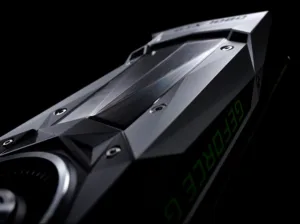Gaming continues to be a demand driver for HDR and high frame rates on PCs, and Nvidia aims to fulfil that need with its new GTX1080 and GTX1070 graphics cards. These devices can support HDR and frame rates up to 240Hz. Just as important, though, is that these are the first Nvidia cards built on TSMC’s 16nm FinFET process, rather than the conventional 28nm (which, at this point, has lasted for more than four years).
Both cards are built using the Pascal architecture, with 7.2 billion transistors. Nvidia claims that Pascal offers gamers a doubling in efficiency, compared to Maxwell. It also offers features like Simultaneous Multi-Projection, which can be used to create up to 16 viewports. Nvidia is also promoting Pascal for more efficient implementations of VR lens distortion corrections and rendering the same scene twice in VR – once for each eye – in a single pass.
Future-proofing is the name of the game, with the GTX1080 supporting resolutions up to 8k (7680 x 4320) at 60Hz. 1920 x 1080 and 2160 x 1440 will be supported at 240Hz; 3440 x 1440 at 190Hz; and UltraHD at 120Hz. These specifications have not been announced for the GTX1070 yet, but we know that it is a more affordable version of the GTX1080, so expect to see some compromises.
Both cards are described as ‘DisplayPort 1.2 Certified, DisplayPort 1.3/1.4 Ready’. DisplayPort 1.3/1.4 are not certified themselves yet. HDMI 2.0b and dual-link DVI connections are also supported. They also support GDDR5X/GDDR5 (1080/1070) RAM. Memory speed is up to 10Gbps.
Nvidia will launch the GTX1080 on the 27th May for $600, and the GTX1070 on the 10th June for $380.

